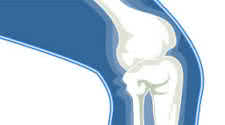Strengthen Bones & Joints Naturally with Exercise and Fitness Programs

Exercise and Fitness have Lifetime Benefits
Exercise builds and tones up muscles, and keeps your ligaments and tendons supple. Recent research shows that it also helps maintain bone
strength. The exercise habits you develop while you are young have a big influence on your health and fitness, but only as long as you
keep up your activities. If you don't stick with your good workout habits as you get older, you'll lose much of your hard-won muscle
strength, your ten-dons and ligaments will lose elasticity which will let your joints stiffen, and now we know you'll even lose bone
strength.
There is a tendency for bones to lose calcium as you grow older. As this happens, bones become porous and brittle, and break more easily
due to falls and other accidents. This condition is called osteoporosis, and Sandra C. Raymond, executive director of the National
Osteoporosis Foundation in Washington, D.C., estimates that this disease affects more than four million American men.
Exercise and Bone Density
Regular exercise is an effective way to keep your bone density high, and reduce risk of trouble later in your life. Recent work, discussed at the 1990 Annual Meeting of the American College of Sports Medicine in Salt Lake City, shows that although exercise helps to keep bones strong, evidence is accumulating that the positive effects of exercise are specific. For example, work-outs for your legs strengthen your leg bones, but don't do anything for your arms. This makes it important for you to incorporate into your program load-bearing exercises for your arms, legs and trunk.Joan Martin, Ph.D., and colleagues at McMaster University in Hamilton, Ontario, measured bone densities of 43 men, aged 20 to 35, who ran from as little as five to 10 miles a week to more than 40 miles a week. They found that bone density of the runners' leg bones increased with mileage up to 15 to 20 miles a week, and then leveled off. By contrast, there was a tendency for bone density of the men's trunks to decrease with running mileage.
This result is parallel to earlier data from the University of Maryland. Jo Ellen Bilanin, M.A., and colleagues, found that bone mineral density in the legs of young men who ran 40 or more miles a week was in the range expected for weight-bearing bone. Bone density in their backs was not.
A study of young runners, average age 13, at Michigan State University, found a tendency for the bone mineral content of the arms to be lower than in a matched control group who were active but did not run. The data for girls was not statistically significant, but according to Carol Rogers, Ph.D., for boys it was, and amounted to nearly a 10 percent difference.
By contrast, elite weightlifters seem to show an overall advantage, compared to normal men. A collaboration between researchers at the University of Connecticut Health Center, Pennsylvania State University, the U.S. Olympic Committee in Colorado Springs, and Appalachian State University in Boone, N.C., measured bone mineral density at various body sites on members of the 1989 Junior National Weightlifting Team.
As muscular strength in the snatch, clean and jerk, and the combination of both increased, so did the bone mineral density in both the legs and the lower back. Says Brian P. Conroy, Ph.D., "Heavy resistance exercise may substantially increase bone mineral density; with the increases being influenced by the chronic overload training."
Keeping Bones Strong
There are several things you need to do to keep your bones healthy and strong. First, you must have enough calcium in your diet. The Recommended Dietary Allowance is 800 milligrams (mg) a day (1,200 mg, if you are between 11 and 24 years old). Low-fat or skim milk has 300 mg per cup, and one cup or an ounce or two of other dairy products have 200 to 300 mg of calcium. Other good sources of calcium are canned sardines and salmon, with bones (200 to 400 mg in three or four ounces), and dark green vegetables such as kale and broccoli (25 to 45 mg in each ounce).Along with calcium, you need Vitamin D, which is manufactured in your skin under the influence of sunlight. You need to be in direct sunlight for 10 to 15 minutes at least twice a week to meet your need for this vitamin.
These precautions will not be enough to preserve your bone strength unless you work out your arms, legs, and trunk. According to Evelyn Whitlock, M.D., in "The Calcium Plus Workbook," the most effective activities are lifting weights, using a trampoline, aerobic dancing, jumping rope, tennis, walking, hiking and running.
Remember, though, the researches cited above that suggest you need to load all the major bone groups; aerobic exercises such as walking and running don't do that. There are also non weight-bearing exercises that can help, such as calisthenics, rowing, cycling and swimming, but they are less effective in keeping your bones strong. Combine your activities in a way that gives you all-around benefits.
You must also make a lifelong commitment to exercise. The way to maintain strong bones is to keep up your workouts. Sports medicine experts believe that most of the effects of aging are due to inactivity, not the passing of the years. In fact, Maria Fiatarone, M.D., of the USDA Human Nutrition Research Center on Aging at Tufts University in Boston, has said that loss of strength in older people is due "most significantly, to atrophy of disuse."